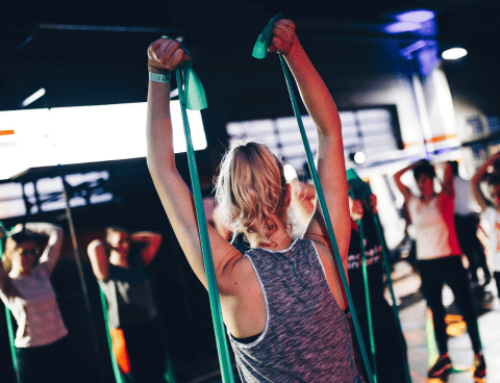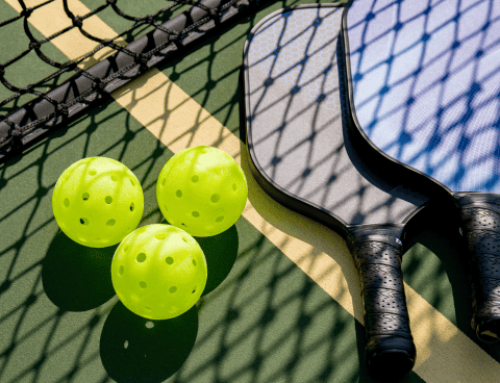Why Everybody Botches Single-Leg Deadlifts (and How to Finally Master Them)
The Single-Leg Deadlift is an advanced movement that will challenge foot, hip and torso stability while also developing posterior strength.
It’s also one of the best lower-body movements an athlete can include in their routine. I consider it the Holy Grail of single-leg posterior chain exercises. Reasons Single-Leg Deadlifts are awesome include:
- They’re an authentic single-leg movement, meaning SLDLs will have carryover to movements like running and cutting.
- They teach you to load and develop force through one leg.
- They increase stability in the face of external environmental forces.
- They target posterior lower-body muscle groups, something that’s sorely needed when most people are so quad dominant.
Here’s what the move looks like with a single kettlebell, which is how I recommend beginners execute it before trying to move on to two kettlebells, two dumbbells or a barbell:
Looks easy enough, right? But truth is that the Single-Leg Deadlift is one of the most frequently botched exercises in existence. Poor form drastically reduces the effectiveness of the movement. Let’s run through some common mistakes and provide fixes for each.
1. Lowering Instead Of Reaching
The first movement of the SLDL should be a reaching back of the foot, but we often first think of lowering the weight to the ground. This mistake can cause a rounding of the lower back to move the weight down instead of using the hips to move the weight down.
The Fix: Think of initiating the exercise by reaching the sole of your shoe back to the wall or kicking the back door out. The Foot on Wall SLDL exercise outlined below is great for practicing this.
2. Opening the Hip
During the SLDL, the hips should stay level, allowing the glutes to do the majority of the work. You want to avoid letting the hip of your extended leg lift higher than the hip of your grounded leg as you lower your weight. Unfortunately, this is easier said than done, as many people you see performing an SLDL will fall victim to uneven hips.
The Fix: Pay attention to the grounded foot and make sure you are staying rooted into the ground instead of rolling out to the pinky side. Instead of thinking about lowering the weight in a straight line, think of placing the weight next to the big toe of your grounded foot. The Staggered SLDL exercise outlined below is great for practicing this.
3. Not Feeling the Ground
Piggybacking off the last mistake, we often think of getting the weight from point A to point B during an SLDL and lose focus of the only contact point with the ground. Big mistake. By not paying attention to the contact of the foot on the ground, we will not be able to stabilize the rest of the body or produce force efficiently. A shaky, wobbly foundation makes it impossible to nail the movement.
The Fix: Don’t just stand on the ground, but push into the ground. You should feel the weight in your toes and heel and side of your feet equally; you should not be feeling just the heel or just the inside or outside of your foot. The more surface area of your foot you utilize, the better your balance and stability will be.
4. Turning It Into a Balancing Exercise
The SLDL is not a balancing act, it is an exercise to strengthen the leg and the hip while also helping to increase single-leg stability. Many people start off ok but as fatigue sets in and they gradually lose focus throughout a set, end up looking like they’re on ice skates.
The Fix: Rest and take a breath between reps to ensure that you are stable. Don’t rush through sets. It is OK to finish with both feet on the ground between each rep to ensure you are keeping the exercise under control.
Five Steps to Perfect Single-Leg Deadlifts
If you’re someone who has trouble with SLDLs or someone who has never tried them before, going through the following five-step progression can really help you clean up your form and master this challenging movement.
1. Cook Hip Lift
This teaches you to keep hip flexion on one side and get hip extension on the other side, which is what happens during actions like running as well as the SLDL. Complete three sets of 8-10 reps on each side. Once you’re nailing this movement, move onto step two.
2. Romanian Deadlifts (RDL)
You have to know how to hinge on two feet before you can hinge on one leg. Complete three sets of 8-10 reps. Once you’re nailing this movement, move onto step three.
3. Staggered RDL
This variation moves closer to the SLDL. By stepping one foot back and putting most of the weight on the front leg, you will essentially be performing an SLDL but with a kickstand for extra stability. This will help you practice keeping your hips level. Perform three sets of six reps on each side. Once you’re nailing the movement, move onto step four.
4. Foot on Wall SLDL
This variation moves you even closer to the SLDL, decreasing the help from the back leg and requiring more work from the stance leg. This helps with that “kick through the back door” cue we talked about earlier, which is so important to nailing the real SLDL. Complete three sets of six reps on each side. Once you’re nailing the movement, move onto step five.
5. SLDL
You made it to the Holy Grail of single-leg posterior chain exercises! This would be an excellent time to break out your phone and post a video to the world, for they too, will want to bask in the glory that is a well-executed SLDL.
Over time, you can progress to heavier and/or different implements. Generally speaking, you’ll want to stay in the range of three sets of 6-10 reps on each side. Remember, if you need to take a mid-set rest to keep your form clean, that’s perfectly OK. Many of the issues that arise with the Single-Leg Deadlift come from rushing through the movement and focusing on simply getting the weight from A to B without thinking about the right things your body should be doing to accomplish that.
Photo Credit: PABLO DUNAS/iStock
READ MORE:
RECOMMENDED FOR YOU
MOST POPULAR
Why Everybody Botches Single-Leg Deadlifts (and How to Finally Master Them)
The Single-Leg Deadlift is an advanced movement that will challenge foot, hip and torso stability while also developing posterior strength.
It’s also one of the best lower-body movements an athlete can include in their routine. I consider it the Holy Grail of single-leg posterior chain exercises. Reasons Single-Leg Deadlifts are awesome include:
- They’re an authentic single-leg movement, meaning SLDLs will have carryover to movements like running and cutting.
- They teach you to load and develop force through one leg.
- They increase stability in the face of external environmental forces.
- They target posterior lower-body muscle groups, something that’s sorely needed when most people are so quad dominant.
Here’s what the move looks like with a single kettlebell, which is how I recommend beginners execute it before trying to move on to two kettlebells, two dumbbells or a barbell:
Looks easy enough, right? But truth is that the Single-Leg Deadlift is one of the most frequently botched exercises in existence. Poor form drastically reduces the effectiveness of the movement. Let’s run through some common mistakes and provide fixes for each.
1. Lowering Instead Of Reaching
The first movement of the SLDL should be a reaching back of the foot, but we often first think of lowering the weight to the ground. This mistake can cause a rounding of the lower back to move the weight down instead of using the hips to move the weight down.
The Fix: Think of initiating the exercise by reaching the sole of your shoe back to the wall or kicking the back door out. The Foot on Wall SLDL exercise outlined below is great for practicing this.
2. Opening the Hip
During the SLDL, the hips should stay level, allowing the glutes to do the majority of the work. You want to avoid letting the hip of your extended leg lift higher than the hip of your grounded leg as you lower your weight. Unfortunately, this is easier said than done, as many people you see performing an SLDL will fall victim to uneven hips.
The Fix: Pay attention to the grounded foot and make sure you are staying rooted into the ground instead of rolling out to the pinky side. Instead of thinking about lowering the weight in a straight line, think of placing the weight next to the big toe of your grounded foot. The Staggered SLDL exercise outlined below is great for practicing this.
3. Not Feeling the Ground
Piggybacking off the last mistake, we often think of getting the weight from point A to point B during an SLDL and lose focus of the only contact point with the ground. Big mistake. By not paying attention to the contact of the foot on the ground, we will not be able to stabilize the rest of the body or produce force efficiently. A shaky, wobbly foundation makes it impossible to nail the movement.
The Fix: Don’t just stand on the ground, but push into the ground. You should feel the weight in your toes and heel and side of your feet equally; you should not be feeling just the heel or just the inside or outside of your foot. The more surface area of your foot you utilize, the better your balance and stability will be.
4. Turning It Into a Balancing Exercise
The SLDL is not a balancing act, it is an exercise to strengthen the leg and the hip while also helping to increase single-leg stability. Many people start off ok but as fatigue sets in and they gradually lose focus throughout a set, end up looking like they’re on ice skates.
The Fix: Rest and take a breath between reps to ensure that you are stable. Don’t rush through sets. It is OK to finish with both feet on the ground between each rep to ensure you are keeping the exercise under control.
Five Steps to Perfect Single-Leg Deadlifts
If you’re someone who has trouble with SLDLs or someone who has never tried them before, going through the following five-step progression can really help you clean up your form and master this challenging movement.
1. Cook Hip Lift
This teaches you to keep hip flexion on one side and get hip extension on the other side, which is what happens during actions like running as well as the SLDL. Complete three sets of 8-10 reps on each side. Once you’re nailing this movement, move onto step two.
2. Romanian Deadlifts (RDL)
You have to know how to hinge on two feet before you can hinge on one leg. Complete three sets of 8-10 reps. Once you’re nailing this movement, move onto step three.
3. Staggered RDL
This variation moves closer to the SLDL. By stepping one foot back and putting most of the weight on the front leg, you will essentially be performing an SLDL but with a kickstand for extra stability. This will help you practice keeping your hips level. Perform three sets of six reps on each side. Once you’re nailing the movement, move onto step four.
4. Foot on Wall SLDL
This variation moves you even closer to the SLDL, decreasing the help from the back leg and requiring more work from the stance leg. This helps with that “kick through the back door” cue we talked about earlier, which is so important to nailing the real SLDL. Complete three sets of six reps on each side. Once you’re nailing the movement, move onto step five.
5. SLDL
You made it to the Holy Grail of single-leg posterior chain exercises! This would be an excellent time to break out your phone and post a video to the world, for they too, will want to bask in the glory that is a well-executed SLDL.
Over time, you can progress to heavier and/or different implements. Generally speaking, you’ll want to stay in the range of three sets of 6-10 reps on each side. Remember, if you need to take a mid-set rest to keep your form clean, that’s perfectly OK. Many of the issues that arise with the Single-Leg Deadlift come from rushing through the movement and focusing on simply getting the weight from A to B without thinking about the right things your body should be doing to accomplish that.
Photo Credit: PABLO DUNAS/iStock
READ MORE:











